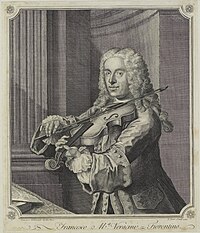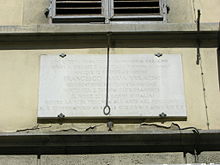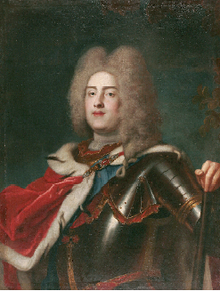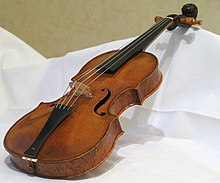
Francesco Maria Veracini (1 February 1690 – 31 October 1768) was an Italian composer and violinist, perhaps best known for his sets of violin sonatas. As a composer, according to Manfred Bukofzer, "His individual, if not subjective, style has no precedent in baroque music and clearly heralds the end of the entire era", while Luigi Torchi maintained that "he rescued the imperiled music of the eighteenth century", His contemporary, Charles Burney, held that "he had certainly a great share of whim and caprice, but he built his freaks on a good foundation, being an excellent contrapuntist". The asteroid 10875 Veracini was named after him.
Life

Francesco Maria Veracini was born at about 8:00 a.m. on 1 February 1690 in the family house on the via Palazzuolo, parish of San Salvatore, Ognissanti, Florence. The second and only surviving son of Agostino Veracini, a pharmacist and undertaker (and ironically one of the few Veracinis who was not a violinist, even as an amateur), he was taught the violin by his uncle, Antonio Veracini, with whom he later often appeared in concert, as well as by Giovanni Maria Casini and his assistant Francesco Feroci. His grandfather, Francesco (di Niccolò) Veracini, had been one of the first violinists of Florence, and ran a music school in the house until ill health forced him to turn the business over to his eldest son, Antonio, in 1708. In addition, the family managed a painting studio and possessed a large collection of art works, including four Ghirlandaios, a Rubens, a Caracci and a dozen other paintings by the three members of the family from two generations, including Francesco's third son, Benedetto. The painter Niccolò Agostino Veracini was Francesco Maria's cousin. Veracini esteemed Carlo Ambrogio Lonati as a great violinist.

He is known to have been a soloist in Venice at the Christmas masses at San Marco, on 24 and 25 December 1711. On 1 February 1712 he performed a violin concerto of his own composition (the first recorded public performance by Veracini playing one of his own compositions), accompanied by trumpets, oboes, and strings as part of the celebrations in honour of the Austrian ambassador to Venice of the newly elected Holy Roman Emperor, Charles VI. The celebration, held in Santa Maria Gloriosa dei Frari included a vocal Te Deum and Mass, as well as motets and concertos performed under the direction of padre Ferdinando Antonio Lazari. The manuscript scores of all the works performed that day, including Veracini's concerto, were bound together in a handsome presentation volume now found in the National Library of Austria. According to another opinion, this concerto was Veracini's Violin Concerto in D Major, "a otto strumenti, di Francesco Maria Ueracini Suonato dallo stesso al post comunio", 1711), but was performed in Frankfurt rather than Venice, at Charles VI's coronation on 22 December 1711, just two days before Veracini's appearance as a soloist on Christmas Eve in Venice, some 800 kilometers to the south.

In 1714, Veracini went to London and played instrumental pieces ("symphonies" in contemporary parlance) between the acts of operas at the Queen's Theatre. At the court of Johann Wilhelm, Elector Palatine and Anna Maria Luisa de' Medici he performed his oratorio Mosè al Mar Rosso. In 1716 he was appointed as the head of a Venetian music school. There is a legend that, when Giuseppe Tartini heard Veracini playing the violin, he was so impressed by his bowing technique, and so dissatisfied with his own skill, that he retreated the next day to Ancona "in order to study the use of the bow in more tranquility, and with more convenience than at Venice, as he had a place assigned him in the opera orchestra of that city".
Veracini wrote a set of violin/recorder sonatas dedicated to Prince Friedrich August, who came to celebrate carnival. The Prince recruited not only singers, as he was told to do by his father, but also musicians for the court in Dresden. He hired an entire opera company under the direction of the Italian composer Antonio Lotti, the librettist Antonio Maria Lucchini, the castrati Senesino and Matteo Berselli, the brothers Mauro architects, two painters, and two carpenters (Charlton 2000). In 1718 the Prince also secured the services of the eccentric Francesco Maria Veracini—at a very high salary— Johann David Heinichen and Giuseppe Maria Boschi.
Dresden


To justify his salary, Veracini had to compose chamber music for the court, transferring him to the official payroll as Kapellmeister in August 1717 and not as a violinist. In 1719 Veracini was sent to recruit more Italian singers for the new Dresden opera, "am Zwinger". Whilst in Venice he secured the services of Margherita Durastanti and Vittoria Tesi and in Bologna added Maria Antonia Laurenti. Veracini also took the opportunity to visit his home town where he married Chiara Tesi.
In 1721 Veracini wrote another set of violin sonatas dedicated to the Prince (published in Dresden as his Opus 1). Unfortunately, there was animosity among all these gifted musicians at the court in Dresden. In 1722, the arrogant Veracini was involved in a quarrel, staged according to one source by the composer and violinist Pisendel, which resulted in Veracini leaping out of an upper-story window and breaking his foot in two places and (also) his hip. There are two conflicting accounts of this incident on August 13, one involving humiliation of Veracini at the hands of the last-desk violinist in the orchestra, who was asked to play the same concerto, replacing Veracini. Pisendel had been rehearsing his composition intensively with this violinist. The braggart Veracini fell into such a rage over this that he did not come out of his room for several days, and out of shame and despair finally publicly threw himself out of a window onto the street in Dresden. According to Veracini the jealous German musicians allegedly plotted to murder him (so he claimed in his writings). He fled Dresden by jumping out a window and apparently broke a leg in the fall. After the incident Veracini walked with a limp for the rest of his life. It is a myth Senesino was involved in the quarrel as he was either dismissed by Heinichen or by the court which ran out of money. G.F. Handel offered the singer a contract for London two years before the alleged incident with Veracini.
It seems the Dresden musicians, fearing for their position, felt relieved Veracini had left the city. Back in his native Florence in 1723, Veracini played music in a church. During this time he suffered from his bad reputation and was said by Charles Burney to have been "usually qualified with the title of Capo pazzo" . He composed a Te Deum for the coronation of Pope Clement XII in 1730.
His uncle Antonio died in 1733, leaving the bulk of his estate to Francesco Maria. Amongst other things, this included no fewer than eight violins made by Jacob Stainer and three Amatis.
London

Back in London in 1733, Veracini appeared in many concerts. In 1735 he composed an opera for the Opera of the Nobility, Adriano in Siria. Francesca Cuzzoni, Antonio Montagnana, Farinelli and Senesino had a role. George Frederic Handel was present at the premiere in Haymarket Theatre. Charles Jennens liked the opera and ordered a score; Lord Hervey, not known for his musical perception, and Henry Liddell, 1st Baron Ravensworth were bored. However, the work enjoyed a run of twenty performances over six months. Many of the arias were published separately by John Walsh . Veracini composed the fifth version, based on Pietro Metastasio’s libretto, written for the Habsburg Emperor Charles VI. The score, which survived in the Newman Flower Collection (or the Henry Watson Music Library?) of the Manchester Central Library was developed by German musicologist Holger Schmitt-Hallenberg along with Fabio Biondi, who composed the recitatives that have not been preserved. It was performed in Kraków December 2013 and in Vienna and Madrid in January 2014.

In 1736 he wrote some arias for the pasticcio Orfeo by Nicola Porpora. In 1737, he wrote La Clemenza di Tito, on a libretto by Angelo Maria Cori based on Metastasio. In 1738 Veracini wrote his third opera, Partenio, and returned to Florence where he stayed till 1741. Back in London he composed his last opera, Roselinda, based on Shakespeare's play As You Like It, a most unusual choice of material at that time. In that opera Veracini included the well-known Scots ballad tune The Lass of Paties Mill. It was staged in London in 1744, the same year his oratorio L'errore di Salomone was staged. Burney, scorned the music of Roselinda as "wild, awkward, and unpleasant; manifestly produced by a man unaccustomed to write for the voice, and one possessed of a capo pazzo", and ridiculed the inclusion of the ballad tune as an attempt "to flatter the English" that failed because "few of the North Britons, or admirers of this national and natural Music, frequent the opera, or mean to give half a guinea to hear a Scots tune, which perhaps their cook-maid Peggy can sing better than any foreigner", but confessed that "This opera, to my great astonishment when I examined the Music, ran twelve nights", whereas L'errore di Salomone was given only twice. Veracini left London a little more than a year later.
In 1745 or shortly after, he survived a shipwreck in which he lost two of his Stainer violins (the ones he called St. Peter and St. Paul), "thought to have been the best in the world", and all of his effects. He returned to Florence, where he was appointed maestro di capella of the churches of San Pancrazio and San Gaetano, the latter one at which his uncle had worked, focusing on church music. Though he mostly conducted in his later years, he still sometimes appeared as a violinist. Veracini died in Florence.
Compositions
In addition to violin sonatas, edited by Ferdinand David, operas and oratorios, Veracini also wrote violin concertos, sonatas for recorder and basso continuo, and orchestral suites, called Overtures. The six Overtures were performed for Prince Friedrich August in Venice in 1716, as part of Veracini's ultimately successful attempt to secure a position at the Dresden court. They are all either in F major or B-flat major, except for one in G minor. The last one of these, in B-flat major, is remarkable for concluding with a unison minuet. Veracini also wrote a "lively, highly original theory treatise", Il trionfo della pratica musicale, and edited other composers' works, adding "improvements" of his own, such as he did in his Dissertazioni with the Opus 5 Violin Sonatas of Arcangelo Corelli.
Major works

- 12 Sonatas for recorder or violin solo and basso (no opus number, dedicated to Prince Friedrich August, before 1716, unpublished in the composer's lifetime)
- Opus 1, 12 Sonatas for violin solo and basso (dedicated to Prince Friedrich August, 1721)
- Opus 2, 12 Sonate Accademiche for violin solo and basso (1744)
- Dissertazioni del Sigr. Francesco Veracini sopra l'opera quinta del Corelli (date of composition uncertain, unpublished until 1961)
- Opus 3, Il trionfo della pratica musicale, osia Il maestro dell’arte scientifica dal quale imparsi non-solo il contrapunto ma (quel che più importa) insegna ancore con nuovo e facile metodo l’ordine vero di comporre in musica (music-theory treatise, 1760)
Discography
- The Art of Bel Canto. Richard Tucker, tenor; John Wustman, piano and harpsichord. LP. Columbia ML 6067 Also issued in stereo, MS 6667 : Columbia, 1965.
- The Art of Joseph Szigeti, vol. 1. Joseph Szigeti, violin; Kurt Ruhrseitz, piano (Recorded 1926–1933). 2 CDs (mono). London, England: Biddulph Recordings, 1989. LAB 005, LAB 006.
- An Arthur Grumiaux Recital. Arthur Grumiaux, violin; Riccardo Castagnone, piano. LP (mono). Epic LC 3414 : Epic Records, 1957.
- Baroque Masters of Venice, Naples and Tuscany. Soloists of the Società cameristica di Lugano. LP. "A Cycnus recording, Paris." : Nonesuch Records, 1966. HC 3008.
- Concerti "per l'orchestra di Dresda". Musica Antiqua Köln; Reinhard Goebel, dir. CD. Archiv Produktion 447 644–2. Hamburg: Deutsche Grammophon, 1993.
- Flute Solos. James J Pellerite, flute; Wallace Hornibrook, piano. Coronet LPS 1505 (LP). Columbus, Ohio: Coronet, .
- French and Italian Flute Music. Barthold Kuijken, flute; Wieland Kuijken, viola da gamba; Robert Kohnen, harpsichord. 2 CDs. Accent ACC 30009. Heidelberg: Accent, 2007.
- Furiosi. I Furiosi (Gabrielle McLaughlin, soprano; Aisslinn Nosky, Julia Wedman, violin; Felix Deak, violoncello, viola da gamba); with James Johnstone, harpsichord; Stephanie Martin, organ; Lucas Harris, theorbo and guitar. CD. Dorian DSL-90802. Winchester, VA: Dorian, 2007.
- Italian Baroque Songs. Dénes Gulyás, tenor; Dániel Benkö, lute, guitar, orpharion; László Czidra, recorder; Tibor Alpár, organ; Budapest Baroque Trio; Bakfark Consort. CD. Hungaroton HCD 31480. : Hungaroton, 1992.
- Italian Baroque Violin Concerti. Carroll Glenn, violin; Austrian Tonkuenstler Orchestra, Vienna; Lee Schaenen, conductor. LP. Musical Heritage Society MHS 652 New York: Musical Heritage Society, 1966.
- The Italian Connection: Vivaldi, Corelli, Geminiani, Lonati, Veracini, Matteis. Bell'arte Antiqua (Lucy van Dael, Jacqueline Ross, violins; William Hunt, viola da gamba; Terence Charlston, harpsichord). CD. London: ASV, 2000. CD GAU 199.
- Italian Music for Strings of the Baroque Period. Cambridge Society for Early Music; Erwin Bodky, director; Ruth Posselt, Richard Burgin, violins. LP (mono). Kapp KCL 9024
- An Italian Sojourn. Trio Settecento. CD. Chicago: Cedille, 2006.
- Italian Violin Sonatas. Europa Galante (Fabio Biondi, violin and direction; Maurizio Naddeo, violoncello; Giangiacomo Pinardi, theorbo, baroque guitar, cittern; Sergio Ciomei, harpsichord, organ, gracivembalo, clavichord). Virgin Veritas 5 45588 2 (CD). : Virgin, 2002.
- Italienische Blockflötenmusik des 17. und 18. Jahrhunderts. Eckhardt Haupt, recorder; Achim Beyer, violin; Christine Schornsheim, harpsichord; Siegfried Pank, tenor viola da gamba. CD. Capriccio 10 234. Königsdorf: Delta Music GmbH, 1988.
- Blockflötenwerke von 10 italienischen Meistern. Frans Brüggen, recorder; Anner Bylsma, violoncello; Gustav Leonhardt, harpsichord and organ. 3LPs. Telefunken Das Alte Werk 6.35073. Hamburg: Telefunken, 1968–74. Reissued on CD as Italian Recorder Sonatas. Teldec 4509-93669-2. Hamburg: Teldec, 1995.
- Masters of the Italian Baroque. Steven Staryk, violin. Kenneth Gilbert, harpsichord. LP. Baroque BUS 2874. Baroque Records, .
- Maurice André Plays Trumpet Concertos. Maurice André, trumpet; Pierre Pierlot, oboe; Orchestre de chambre Jean-François Paillard, Jean François Paillard, cond. (LP) New York, N.Y.: Musical Heritage Society, 1969.
- Six Italian Sonatas. Michel Piguet, baroque oboe and recorder; Walther Stiftner, baroque bassoon; Martha Gmünder, harpsichord. Musical Heritage Society MHS 1864 (LP). New York: Musical Heritage Society, 1974. Title from container./ "Recorded by Erato."
- Tetrazzini. Luisa Tetrazzini, soprano; with unidentified orchestras. Recorded between 1909 and 1914, digitally re-recorded from the original 78 rpm discs. CD. Wyastone Leys, Monmouth: Nimbus Records, 1990.
- Veracini, Francesco Maria. 5 ouvertures / Ouvertüren / Overtures. Musica Antiqua Köln; Reinhard Goebel, dir. CD. Archiv Produktion 439 937-2. Hamburg: Deutsche Grammophon, 1994.
- Veracini, Francesco Maria: Complete Overtures and Concertos, vol. 1. Accademia i Filarmonici; Alberto Martini, conductor. CD. Naxos 8.553412. Munich: Naxos, 1995.
- Veracini, Francesco Maria: Complete Overtures and Concertos, vol. 2 Accademia i Filarmonici; Alberto Martini, conductor. CD. Naxos 8.553413. : Naxos, 1999.
- Veracini, Francesco Maria. The Complete Sonatas, op. 1. Hyman Bress, violin; Jean Schrick, viola da Gamba; Oliver Alain, harpsichord. 3 LPs. Lyrichord and LLST 7141 (set); LLST 7138, LLST 7139, LLST 7140. Lyrichord;. New York: Lyrichord Records, 1965.
- Veracini, Francesco Maria. Nine Sonatas for Violin and Basso Continuo. Piero Toso, violin; Gianni Chiampan, violoncello; Edoardo Farina, harpsichord. 2 LPs. Erato 71197. Reissued on Musical Heritage Society MHS 4293, MHS 4294. Tinton Falls, N.J.: Musical Heritage Society, 1978. "Licensed from."
- Veracini, Francesco Maria. Six Sonatas for Flute and Harpsichord. Giorgio Bernabò, flute; Alan Curtis, harpsichord. CD. Dynamic CDS 114. Genoa: Dynamic Srl, 1994.
- Veracini, Francesco Maria. Sonatas. John Holloway, violin; Jaap ter Linden, cello; Lars Ulrik Mortensen, harpsichord. CD. ECM New Series Munich: ECM Records, 2003.
- Veracini, Francesco Maria. Sonate accademiche. Fabio Biondi, violin; Maurizio Naddeo, violoncello; Rinaldo Alessandrini, harpsichord; Pascal Monteilhet, theorbo. CD. Paris, France: Opus 111, 1995. OPS 30–138.
- Veracini, Francesco Maria: Sonate accademiche. The Locatelli Trio (Elizabeth Wallfisch, violin; Richard Tunnicliffe, violoncello; Paul Nicholson, harpsichord & organ). 3 CDs. Hyperion CDA 66871/3. London: Hyperion Records Ltd., 1995. Reissued 2007, Hyperion CDS44241/3.
- The Virtuose Italienische Blockflötenmusik. Michael Schneider, recorder; Michael McCraw, bassoon; Gerhart Darmstadt, cello; Bradford Tracey, harpsichord. CD. FSM Adagio FCD 91 634 Münster: Fono Schallplattengesellschaft mbH, 1990.
- The Virtuoso Harmonica. Adalberto Borioli, harmonica; Mirna Miglioranzi-Borioli, harpsichord. LP. Everest SDBR 3172. Los Angeles, Calif.: Everest, 1967.
- The Virtuoso Recorder. Frans Brüggen, recorder; Janny van Wering, harpsichord. LP. Decca DL 710049. New York: Decca, 1962.
- The Virtuoso Violinist. David Nadien, violin; Boris Barere, piano. LP. Kapp KCL 9060. : Kapp Records, 1961
Sources
- Anon. 1734. Adriano in Siria: Dramma per musica. Versione sintetica a cura di www.librettidopera.it (accessed 1 February 2014).
- Anon. 2013. "Adriano in Siria: Dramma per musica". Libretti d’opera italiana (www.librettidopera.it, accessed 3 February 2014).
- Anon. 2014. About the Henry Watson Music Library: Central Library Temporary Closure. (Accessed 1 February 2014).
- Bukofzer, Manfred F. (1947). Music in the Baroque Era: From Monteverdi to Bach. New York City: W. W. Norton – Reprint London: J. M. Dent & Sons, 1948. ISBN 0-460-03431-6.
- Burney, Charles (1789). A General History of Music, from the Earliest Ages to the Present Period. To Which Is Prefixed, a Dissertation on the Music of the Ancients. Vol. 4 vols. (2nd ed.). London: Printed for the author and sold by T. Becket, J. Robson, and G. Robinson.
- Charlton, David. 2000. "Johann David Heinichen (1683–1729)". ClassicalNet (accessed 3 February 2014).
- Hill, John Walter (1979). "The Life and Works of Francesco Maria Veracini". Studies in Musicology (3). Ann Arbor MI: UMI Research Press.
- Hill, John Walter (November 1990). "Antonio Veracini in Context: New Perspectives from Documents, Analysis, and Style". Early Music. 18 (4): 545–62. doi:10.1093/earlyj/XVIII.4.545.
- Hill, John Walter (2001). "Veracini, Francesco Maria". In Stanley Sadie; John Tyrrell (eds.). The New Grove Dictionary of Music and Musicians (2nd ed.). London: Macmillan Publishers.
- Lecerf de la Viéville de Fresneuse, Jean Laurent. 1722. "Des Französischen Anwalds", , in Critica Musica 1, no. 3, parts 7 (November): 189–207, and 8 (December): 209–31.
- . 1722. "Neues: Von musicalischen Sachen und Personen: Dresden". Critica Musica 1, no. 2, part 5 (September): 151–52.
- . 1723. "". Critica Musica 1, no. 4, part 10 (February): 287–88 (accessed 7 February 2014).
- Ministry of Culture and National Heritage of the Republic of Poland. 2013. "Jacek Majchrowski, Mayor of the City of Krakow, Invites: Europa Galante". Serwis www.operarara.pl website (accessed 1 February 2014).
- Rees, Abraham.1819. "Veracini, Antonio". The Cyclopædia: Or, Universal Dictionary of Arts, Sciences, and Literature, Volume 36. London: Longman, Hurst, Rees, Orme & Brown.
- Sadie, Julie Anne (1998). Companion to Baroque Music. University of California Press. ISBN 9780520214149.
- Talbot, Michael. 1974. "Some Overlooked MSS in Manchester". The Musical Times 115, no. 1581 (November): 942-44.
- Torchi, Luigi (1969) . La musica istrumentale in Italia nei secoli XVI, XVII e XVIII, con 272 esempi musicali nel testo (Facsimile reprint of Forni Editore ed.). Turin: Fratelli Bocca.
Footnotes
- Bukofzer 1947, p. 234.
- Torchi 1969, p. 180.
- ^ Burney 1789, 4:569.
- Hill 1979, p. 7.
- Hill 1979, pp. 3–4; Hill 1990, p. 550; Hill 2001.
- Hill 1979, p. 4.
- Hill 2001.
- Hill 1979, p. 11; Sadie 1998, p. 48.
- Kolneder, Walter. 1959–61. "Vorwort". In Francesco Maria Veracini, Zwölf Sonaten für Blockflöte (Querflöte/Violine) und Basso Continuo, 4 vols., edited and with a realization of the figured bass by Walter Kolneder, 1:5. Leipzig: Edition Peters.
White, Mary Gray. 1972. "The Life of Francesco Maria Veracini". Music & Letters 53, no. 1 (January) 18–35 - Sminthe, C. 2013. "Giuseppe Tartini". A Violin's Life: The Lipiński Stradivarius website (accessed 5 February 2014).
- Burney 1789, 3:564–65.
- Greene, David Mason (1985). "Veracini, Francesco Maria". Greene's Biographical Encyclopedia of Composers. Garden City NY: Doubleday. p. 263. ISBN 9780385142786.
- Byram-Wigfield, Ben (2013). "Antonio Lotti's Teofane". Ancient Groove Music. Retrieved 5 February 2014.
- Landmann, Ortrun. 2013. "Verzeichnisse der ehemaligen Mitglieder der Sächsischen Staatskapelle Dresden, ihrer alten Benennungen, ihrer Adminidtratoren [sic] und ihrer musikalischen Leiter von 1548 bis 2013 (mit jährlichen Aktualisierungen) in systematisch-chronologischer Folge". Sächsische Staatskapelle Dresden (staatskapelle-dresden.de, accessed 3 February 2014). p. 5.
- Cramer, Carl Friedrich. 1784. Magasin der Musik, Zweyter Jahrgang, Häfte 1:374.
- White, Mary Gray (January 1972). "The Life of Francesco Maria Veracini". Music and Letters. 53 (1): 23. JSTOR 733657.
- ^ Shulman, Laurie. 2013. "Program Notes". The William T. Kemper International Chamber Music Series (Friday, 11 April): p. 89.
- Anon. "Senesino, from Dresden to London". Les Ambassadeurs. Archived from the original on 23 February 2014. Retrieved 5 February 2014.
- Burney 1789, 3:568.
- Hill 1990, pp. 550, 562n34&43.
- Hill 1979, p. 22.
- Burden, Michael. 2007. "Metastasio on the British Stage 1728–1840 a Catalogue". Royal Musical Association Research Chronicle, no. 40. ISSN 1472-3808. Pre-publication version, in three parts online: Contents. i–xviii., Introduction, 1–28, The Catalogue, 29–158. Oxford University Research Archive: Bodleian Libraries. p. 31.
- Dean, Winton. 2006. Handel's Operas, 1726–1741. The Boydell Press. Woodbridge. ISBN 1-84383-268-2. pp. 278–9.
Til, Marian van. 2007. George Frideric Handel: A Music Lover's Guide to His Life, His Faith and the Development of Messiah and His Other Oratorios. Youngstown, NY: WordPower Publishing. ISBN 9780979478505. p. 121. - Helyard, Erin. 2000 "CD Information: Sirius Ensemble: Veracini Violin Sonatas Op 1. AW024". Artworks: The Australian Classical Music Label (accessed 3 February 2014).
- Skowrońska, Barbara (2013). "Opera Rara: Adriano in Siria". Karnet (karnet.krakow.pl). Archived from the original on 21 February 2014. Retrieved 3 February 2014.
Anon. (12 December 2013). Adriano in Siria—Opera Rara 2013—reportaż. YouTube – kbf. Archived from the original on 2021-12-12. Retrieved 3 February 2014.
Anon. (June 2013). "Europa Galante, Fabio Biondi, Direction and Violin". Satirino Records. Archived from the original on 5 December 2013. Retrieved 3 February 2014. - Sechi, Giovanni Andrea. 2021. L'Orfeo di Porpora e Veracini: un pasticcio per Farinelli, in Mito, Storia e Sogno di Farinelli, ed. Luigi Verdi, Lucca, Libreria Musicale Italiana, 2021, pp. 217–255
- Burney 1789, 4:451 describes it as an opera.
- Burney 1789, 4:451.
- Newman, William S. 1972. The Sonata in the Baroque Era. 3d edition. New York: W. W. Norton & Co.
External links
- List of works by Francesco Maria Veracini
- Free scores by Francesco Maria Veracini at the International Music Score Library Project (IMSLP)
- World's first recording of Veracini's Violin Sonatas featuring Luigi Mangiocavallo (violin)
- Performance of Overture in G minor by the Akademie für Alte Musik Berlin from the Isabella Stewart Gardner Museum in MP3 format